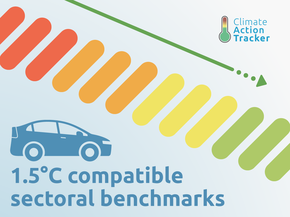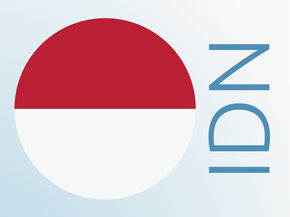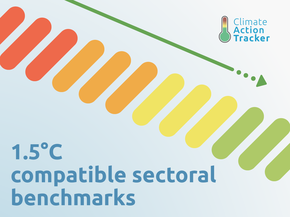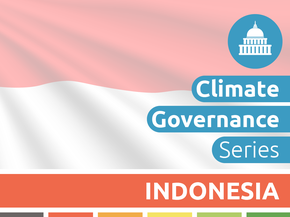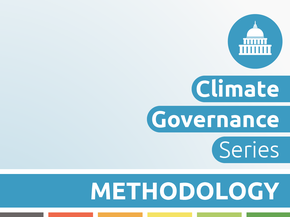Country summary
Overview
NOTE: We will update our quantitative assessment of Indonesia’s current policy projections and targets in 2025. This update will incorporate an assessment of key policy documents—such as the National Energy Policy (KEN), National Energy General Plan (RUEN), National Electricity Master Plan (RUKN), Electricity Supply Business Plan (RUPTL), and the Second NDC— all of which are under development by the government and expected to be published in 2025. This current update is a qualitative assessment of recent climate policy developments.
Indonesia's climate policy presents a complex and contradictory picture, marked by a clear tension between the country's gradual efforts to promote renewable energy, its continued reliance on fossil fuels, and significant emissions from deforestation. Overall, Indonesia's progress in transitioning to a low-carbon economy remains limited, with little meaningful change across critical sectors. Power generation and industry remain heavily reliant on coal, while demand for palm oil continues to be the primary driver of widespread deforestation and land use sector emissions. Indonesia's overall rating remains "Critically insufficient."
The current NDC (2022) and the draft 2035 NDC (2024) both present unambitious emission reduction targets as Indonesia can already meet both under existing policies (without the need for additional, more ambitious policies), and the NDCs fail to address the increase in emissions caused by off-grid coal-fired electricity. If kept as is, the draft 2035 NDC would represent a missed opportunity for Indonesia to increase its climate action and set realistically achievable and actually ambitious targets that are aligned with the 1.5˚C warming limit of the Paris Agreement.
Under the newly-inaugurated administration of President Prabowo Subianto in October 2024, Indonesia stands at a critical juncture in its climate and energy policies. Some plans developed under the new government's focus on sustaining economic development and enhancing self-sufficiency, particularly through initiatives like the food estate programme that aims to reduce reliance on food imports, raise significant environmental concerns, including potential deforestation, biodiversity loss, and displacement of indigenous communities.
In November 2024, the President made ambitious announcements at various high-level international forums about the country's energy transition, pledging to retire all fossil fuel and coal-powered plants within 15 years and achieve net-zero emissions before 2050, a decade earlier than previously indicated. While these announcements signal a positive shift in the country’s energy and climate commitments, the complexity of Indonesia’s power sector and the existing policy and regulatory framework present structural barriers to implementing these pledges quickly. The President’s leadership in reforming the regulatory framework and aligning policies is a prerequisite to achieving these targets.
The November 2022 Just Energy Transition Partnership (JETP) Joint Statement between Indonesia and the International Partners Group (IPG) marked a milestone in international climate cooperation. The partnership aims to increase renewables to 44% of the on-grid power mix by 2030 (from 15% in 2023) and reach net-zero on-grid emissions by 2050 through: 1) early retirement and managed phase-out of coal plants and 2) supporting the upscaling of renewable power.
However, several concerns about the overall targets and plans outlined in the 2023 Comprehensive Investment and Policy Plan (CIPP) have emerged, mainly due to target misalignment with the 1.5°C pathway, insufficient funding, and a lack of just transition plans for impacted communities.
Indonesia's emissions from land-use, land-use change, and forestry (LULUCF), also known as forestry and other land use (FOLU), have accounted for nearly half of the country's total emissions over the past 20 years, reaching around 1 GtCO2e per year, with palm oil-driven deforestation the biggest cause. Indonesia aims to reach a net negative 140 MtCO2e in GHG emissions by 2030 under its FOLU Net Sink programme. However, given current LULUCF emission trends and policy projections estimating an increase in emissions of around 920 MtCO2e per year in 2030, it is uncertain how Indonesia will achieve such steep reductions within this short timeframe.
In August 2024, Indonesia released a draft of its Second Nationally Determined Contribution (SNDC) for public consultation, which includes updated 2030 targets and new 2035 climate goals. The draft unconditional target reflects minimal climate action, while the conditional pathways are misaligned with the CAT’s global least-cost 1.5°C pathway. These conditional pathways rely heavily on delaying significant action until emissions peak in 2035, followed by steep reductions to reach net zero by 2060—an approach that lacks credibility given the inadequate current policies in place and poses a substantial risk of not being achieved without disruptive policy measures, substantial international support, and favourable external factors. For further reading on the preliminary analysis of Indonesia's new climate goals, see our blog.
Indonesia's current policies lead to a strong increase in emissions towards 2030 and do not yet put it on a low-carbon trajectory that uses its vast renewable energy potential. Key measures needed for strengthening Indonesia’s climate action and substantiating the President’s recent ambitious announcements include:
- Aligning energy transition targets and implementation with the Paris Agreement: align JETP targets with the 1.5°C pathway, which, based on CAT’s Paris-aligned benchmarks for the power sector, requires Indonesia to generate at least 55%—and ideally up to 82%—of its energy from renewables by 2030. This calls for expediting the passage of the New and Renewable Energy Bill and establishing a supportive regulatory environment by implementing policies that lower barriers to renewable investment, such as improving the existing renewable energy procurement processes and power purchase agreements within the state-owned electricity company (PLN: Perusahaan Listrik Negara), amending coal-favouring policies, and reforming fossil fuel subsidies in a just and equitable manner.
- Strengthening forest protection and governance to promote sustainable land use management: enhance safeguards against deforestation by upgrading the Presidential Instruction No. 5 of 2019—which imposes a permanent moratorium on deforestation in primary forests and peatlands exploitation—to a legally binding law or presidential regulation for stronger enforcement, while expanding these protections to cover designated concession areas and secondary forests. In addition, improve the robustness of Indonesian Sustainable Palm Oil (ISPO) certification to minimise the impact of biofuels development on deforestation and biodiversity, especially in light of the upcoming plans to increase the biodiesel blend from 35% (B35) to 40-50% (B40-B50).
- Evaluating environmentally harmful development programmes: conduct thorough assessments of mega-projects like the food estate programme (aimed at reducing food imports), and the relocation of the capital from Jakarta to Nusantara in Kalimantan, to prevent environmental degradation, biodiversity loss, and displacement of indigenous communities. Ensure compliance with laws that protect indigenous land rights and explore sustainable alternatives that promote food security without harming ecosystems, e.g. through nutritious crop diversification, food distribution improvement, and investment in sustainable practices.
- Ensuring a just transition by developing operational plans and securing international support: develop clear plans to operationalise the just transition framework and allocate sufficient funds to support affected workers and communities during the coal phase-out, by prioritising reskilling, providing social protection packages, and pushing for economic diversification measures away from coal exports. This can be supported by actively engaging with international partners to secure financial and technical support through mechanisms like JETP.
Despite the uncertain outlook and mixed progress in the development of policies and targets, there have been several positive developments worth highlighting:
- JETP CIPP 2024 updates featuring new investment focus areas and promising progress: the JETP Secretariat is preparing the 2024 Comprehensive Investment and Policy Plan (CIPP), which will include new investment focus areas in energy efficiency and electrification, while integrating the once-overlooked off-grid coal emissions into the technical modelling. The updated CIPP will also highlight advances in financing progress, project approvals, and forthcoming policy reforms.
- Green affordable housing and energy efficiency mandates: through the Indonesia Green Affordable Housing Program (IGAHP), Indonesia aims to build and retrofit one million green housing units by 2030, with a potential emissions reduction of 19-36 MtCO2, and achieve net-zero housing by 2050. With the residential sector making up around 80% of building energy demand, this initiative could play a crucial role in lowering emissions as the country’s middle class continue to grow. A 2023 government regulation also mandates energy efficiency in public buildings and for large energy consumers, reinforcing efforts in reducing buildings sector emissions.
- Public transit electrification and expansion: efforts to extend the Mass Rapid Transit (MRT), Light Rail Transit (LRT), and KRL Commuter Line networks are underway in greater Jakarta, with an LRT system also being considered for Bali—a positive step towards improving the currently limited public transit coverage in Indonesian cities. The Bus Rapid Transit (BRT) network is expanding to six pilot cities, with TransJakarta (BRT operator in Jakarta), leading the way by committing to fully electrify its 10,000 bus fleet by 2030, promoting low-carbon public transportation and improving urban air quality.
Indonesia must urgently reconcile its economic development ambitions with the pressing need to reduce emissions and protect its forests and biodiversity. By adopting stronger climate policies and targets, leveraging international support, and committing to a just transition, Indonesia can work towards aligning its climate action with the Paris Agreement and make a significant contribution to global climate mitigation efforts.
See our Policies and action section for more information.
Description of CAT ratings
The CAT rates each country’s targets and policies against (1) its fair share contribution to climate change mitigation considering a range of equity principles including responsibility, capability and equality, and (2) what is technically and economically feasible using modelled domestic pathways which, in absence of a better method, are based on global least-cost climate change mitigation.
Comparing a country’s fair share ranges and modelled domestic pathways provides insights into which governments should provide climate finance and which should receive it. Developed countries with large responsibility for historical emissions and high per-capita emissions, must not only implement ambitious climate action domestically but must also support climate action in developing countries with lower historical responsibility, capability, and lower per-capita emissions.
The CAT rates Indonesia’s climate targets and policies “Critically Insufficient”. which indicates that Indonesia’s climate policies and commitments currently reflect minimal action and are not at all consistent with the Paris Agreement’s 1.5°C temperature limit. Under Indonesia’s current targets and policies, emissions will continue to rise and are consistent with more than 4°C warming.
Indonesia is far from meeting its fair share contribution to climate change mitigation. Indonesia’s unconditional and policies and action are rated as “Critically insufficient” when compared to its fair share, respectively. Indonesia’s conditional NDC is rated as “Critically Insufficient” considering modelled domestic pathways. As a country with lower responsibility, capability, and per-capita emissions, Indonesia should receive international support to set an ambitious conditional NDC target beyond its national fair share and implement the policies necessary to achieve it.
The CAT rates Indonesia’s policies and actions “Critically Insufficient” when compared to their fair share contribution to climate change mitigation.
The “Critically Insufficient” rating indicates that Indonesia’s climate policies and action reflect minimal action and are not at all consistent with the Paris Agreement’s 1.5°C temperature limit.
In our 2023 assessment, current policy projections increased by around 300 MtCO2e in 2030 compared to the previous 2022 assessment, driven by a huge increase in 2022 emissions and quantification of emissions from Indonesia’s off-grid coal power pipeline. This figure remains unchanged in this update, as we made no quantitative adjustments in this round.
The JETP enhances ambition beyond national plans, but still fails to put Indonesia on a Paris-compatible decarbonisation pathway. To be 1.5°C compatible, Indonesia needs to generate at least 55% of its power from renewables and up to 80% by 2030, for which Indonesia will need significant financial support to reach these levels.
Indonesia’s ETS and the forthcoming carbon tax are promising developments that can help drive its energy transition if implemented well. The Indonesia Carbon Exchange (IDXCarbon) was officially launched in 2023, supporting the expansion of Indonesia’s ETS to cover 99 coal plants in 2023, and up to 146 coal plants in the first quarter of 2024.
There have been some improvements to the regulatory environment for renewables (reform of tariff structure in Presidential Regulation No. 112 of 2022) but policies to support low-carbon development in Indonesia need strengthening to realise their full mitigation potential and to see the global drop in prices for renewable technologies reflected in generation costs (local content requirements, contract terms, and coal price cap).
The full policies and action analysis can be found here.
We rate Indonesia’s conditional NDC target as “Critically insufficient” when compared to modelled domestic pathways. The “Critically insufficient” rating indicates that Indonesia’s internationally supported target in 2030 reflect minimal to no action and are not at all consistent with modelled domestic pathways limiting warming to 1.5°C temperature.
If all countries were to follow Indonesia’s approach, warming would exceed 4°C.
The CAT’s assessment of Indonesia’s total fair share contribution takes into account its emissions reduction target and its climate finance.
We rate Indonesia’s unconditional target as “Critically insufficient” when compared to its fair share emissions allocation. This rating indicates that Indonesia’s fair share target in 2030 reflects minimal to no action and is not at all consistent with its fair share of the global mitigation effort to limit warming to 1.5°C. If all countries were to follow Indonesia’s approach, warming would exceed 4°C.
Indonesia’s emissions from land-use, land-use change and forestry have accounted for almost half of the country’s total emissions over the last 20 years. Indonesia has improved efforts in this sector and managed to continue the decreasing trend of annual tree cover loss in the last five years. Reducing emissions from deforestation is a vital part of Indonesia’s climate action.
The CAT does not yet evaluate Indonesia’s net zero target given its preliminary nature and lack of more detailed information.
Indonesia has not yet communicated an explicit net zero target but explores scenarios that could lead to net zero by 2060 or sooner in its long-term strategy (LTS) submitted to the UNFCCC in July 2021.
Further analysis
Country-related publications
Stay informed
Subscribe to our newsletter

